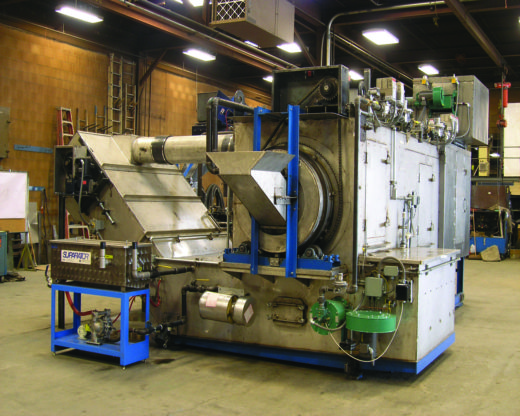There are a multitude of different systems and cleaning technologies available for getting dirty parts clean. In order to budget funds appropriately for the right system, it’s important to carefully evaluate all variables surrounding getting the parts clean and dry.
The purchase of a wash system, as with any capital equipment expenditure should always be closely analyzed to make certain maximum value is gained at minimal cost. However, this does not necessarily equate to the lowest cost equipment yielding the best cleaning results. System types for the processing of high volume small parts can be continuous drum, batch drum, rotary basket, dunk tank and conveyor belt systems. Each system type can vary greatly in size, features, material handling complexity, and process enhancements such as ultrasonic, and mass solution flow.
Cleaning equipment projects for small parts can sometimes be viewed as lower budget projects. In order to budget funds appropriately for this type of project it is important to first carefully evaluate the best possible cleaning system that will sufficiently meet the cleaning and drying objectives of the application. Other factors that can impact the selection of a cleaning system type are process flow and the availability of plant space. Consequently, it is of utmost importance the cleaning and drying requirement be fully understood, and a basics understanding of the process flow and facility considerations be defined prior to deciding what cleaning system type is best for a project.
The purchase of a wash system to clean small parts, as with all capital equipment expenditures, should always be closely analyzed to make certain maximum value is gained at minimal cost. However, this does not necessarily equate to the lowest cost equipment yielding the results required for a process. System types for the processing of high volume small parts can be continuous drum, batch drum, rotary basket with immersion, and even belt type conveyors. Each of these system types can vary greatly in size, feature requirement, material handling complexity, and process enhancements such as ultrasonic, and mass solution flow.
Important considerations for all cleaning applications are the production requirements, sensitive part geometries, critical part areas of cleaning and drying, and the best possible material handling method for processing. In addition, understanding the utility and space requirements, plant environment, and overall process flow are factors that can influence the system type best suited for the application.
Selecting the best cleaning system type for the application is paramount to the success of a project; that is, the system that meets both the cleaning and drying objectives, and works best with the entire flow of a process. Clean and dry parts are inevitably the goal, but selecting for purchase a standard cleaning system, custom, or even a more complex cleaning technology depends on what first is defined as an acceptable level of clean and dry for the part after being processed. Once defined the requirements inside and outside of the cleaning process can be more clearly recognized, and the best cleaning system type for the application can be selected.
Prior to the purchase of a new parts cleaning system, it is essential to have a comprehensive knowledge and broad understanding of all project details in order to properly evaluate the system type that is best suited for an application. Likewise to the importance of the best cleaning system type, is recognizing what material handling method works best with the equipment outside of the cleaning the process. It is critical to understand either the manual handling method or transitions between the mechanical handling systems outside the cleaning process. Understanding these details will not only assist with selection of the cleaning system type, but can help prevent unnecessary labor for manual operations, and possibly limit or eliminate the need for additional material handling equipment.
Effectively communicate the following key project details to suppliers quoting your project:
- What is the contamination to be removed from the parts? Oils, chips, and other fine particles all require different removal methods, and also unique solution separation systems.
- What is an acceptable level of cleanliness, or the part cleaning specification? Visually clean parts, or parts cleaned to a weight or particle size specification require different solution delivery and heating systems, impact techniques, chemistries, and also filtration types.
- What is an acceptable level of solution removal, or the exact drying requirement? Parts delivered at exit simply blown off with no dripping, or completely dry, require vastly different air delivery technologies, air handling techniques, and heating systems.
- What is the material flow into and out of the wash system? Manual parts load/unload, manual basket load/unload, continuous load/unload (or feed) from a mechanized material handling system, or a mechanized batch loading system. Each process can require vastly different material handling methodology inside the wash process, and also transitions between handling systems, which impact system complexity and project scope.
Many other project parameters not mentioned can obviously affect what wash system type is best suited to process small parts; however, production, the cleaning and drying requirement, and also material handling methods are the major factors that determine system type. These important factors also have the greatest impact on complexity, size, project scope and overall cost. Understanding these key factors at the start of a project will ensure the correct system type has been selected for integration into your process.


